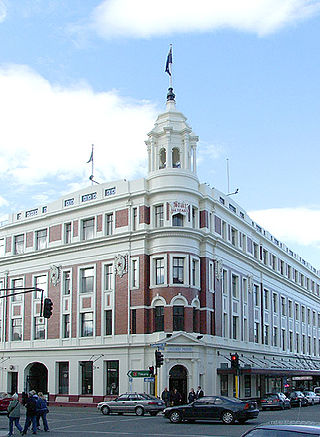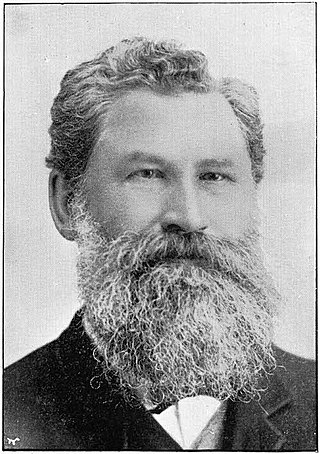
The Star is a free newspaper published weekly in Dunedin, New Zealand by Allied Press since 1979. It is the successor to The Evening Star, which was the city's daily evening newspaper from June 1863 to 1979.

The Star is a free newspaper published weekly in Dunedin, New Zealand by Allied Press since 1979. It is the successor to The Evening Star, which was the city's daily evening newspaper from June 1863 to 1979.
The Star was founded as the Evening Star in 1863 with the first issue appearing on 1 May 1863. It was founded by G. A. Henningham and Co., edited by George Henningham, and originally printed in Stafford Street, above the Exchange area of the city. In its first few years the company was bought by William Henningham, the founder's brother. [1] [2] [3]
In June 1869, William Henningham ran into financial difficulties and the Evening Star was sold by liquidators to George Bell, who also ran a small evening paper, the Evening Independent. Bell merged the two newspapers to form firstly the short-lived Morning Star, and then the far more successful Evening Star, which was first published under this title on 14 June 1869. Under Bell's editorship the paper thrived and it soon began to outsell almost all of its rivals. Bell remained editor until 1894. [4] [1] [3]
Following Bell's resignation, his family gained control of the Evening Star, which became a limited liability public company that was incorporated on 11 April 1895. The company's shareholders were his son George, his six daughters, Louisa's husband Frank Clapperton and Clara's husbands Charles Smith. [5]
Bell was succeeded by Evening Star journalist Mark Cohen as editor in 1894. Under Cohen's leadership, the Star advocated social reform and supported the New Zealand Liberal Party's policies. The Evening Star flourished under Cohen's leadership and attracted several contributors including Presbyterian minister and social reformer Rutherford Waddell. [6] In 1897, the newspaper adopted linotype type-setting machines. [7]
In 1907, the newspaper started a Saturday sports edition called Star Sports, which was published as a tabloid insert. [6] While the Evening Star was a supporter of the Liberals and Prime Minister Richard John Seddon, the newspaper decided after the Liberal's defeat in 1912 not to financially support any political party. This policy was reversed when the Star's board of directors voted to donate NZ£50 to the United Party, a predecessor to the modern National Party. [8]
In 1928, the Evening Star moved to a new headquarters at Stuart Street, which later became the headquarters of Allied Press. [9] Though the Great Depression and the outbreak of the Second World War hindered the newspaper's plans for expansion, the Evening Star benefited from the post-war economic boom in New Zealand. Between 1950 and 1973, the newspaper prospered under the leadership of general manager Vic Cavanagh, a prominent rugby union coach. The Evening Star reached its climax during the 1960s when it had a circulation of more than 30,000. [6] The second-longest lasting of Dunedin's newspapers, The Evening Star became a rival to Dunedin's morning newspaper the Otago Daily Times (ODT). [3]
The Evening Star's readership slowly declined during the period from the 1960s to the 1970s due to competition from commercial radio and television news. 1975, the Evening Star merged with its rival, the Otago Daily Times, to form a holding company called Allied Press. [3] [6] [10] In 1979, Allied Press merged with John M. Fraser and Co Ltd to form a new privately-listed company called Otago Press and Produce Limited (OPP) following takeover attempts by H.W. Smith and Mount Cook Group. [11]
By 1979, the Evening Star's circulation had fallen from 30,000 to under 20,000 due to competition from news broadcasters and its morning sister paper. As a result, the newspaper's sport issue 7 O'clock (the successor to the Star Sports) was discontinued in March 1979. By June 1979, the newspaper had become a tabloid. [12] Due to the newspaper's declining revenue, Allied Press' board dissolved the Evening Star, with its last issue being published on 3 November 1979. [13]
The Evening Star was subsequently replaced by a weekly community paper called The Star. [6] [3] Allied Press still publishes the Otago Daily Times and numerous community and farming papers throughout New Zealand, as well as running Dunedin's local television station, Channel 39. Allied Press also owns the Evening Star's former headquarters at Stuart Street. [14] The company's managing director Julian Smith is a great-great-grandson of George Bell. [3]

Dunedin is the second-largest city in the South Island of New Zealand, and the principal city of the Otago region. Its name comes from Dùn Èideann, the Scottish Gaelic name for Edinburgh, the capital of Scotland. The city has a rich Māori, Scottish, and Chinese heritage.

The Otago Daily Times (ODT) is a newspaper published by Allied Press Ltd in Dunedin, New Zealand. The ODT is one of the country's four main daily newspapers, serving the southern South Island with a circulation of around 26,000 and a combined print and digital annual audience of 304,000. Founded in 1861 it is New Zealand's oldest surviving daily newspaper – Christchurch's The Press, six months older, was a weekly paper until March 1863.

Allied Press is an independent New Zealand media and publishing company based in Dunedin. The company's main asset is the Otago Daily Times, New Zealand's oldest daily newspaper. Allied Press has a number of other daily and community newspapers and commercial printing operations throughout the South Island including the Canterbury–based media company Star Media. It also formerly operated Dunedin's regional television station, Channel 39.
The following lists events that happened during 1863 in New Zealand.
The following lists events that happened during 1861 in New Zealand.

Sir John Larkins Cheese Richardson was a 19th-century New Zealand politician, and a cabinet minister.
The Oamaru Mail is a weekly community newspaper published each Friday in Oamaru, New Zealand, by the Dunedin–based media company Allied Press Ltd that serves the North Otago area. The motto of the paper is "Your community, Your News".

The Southland Times is the regional daily paper for Southland, including Invercargill, and neighbouring parts of Otago, in New Zealand. It is now owned by media business Stuff Ltd, formerly the New Zealand division of Fairfax Media.
Victor George Cavanagh, known as "Young Vic" Cavanagh, was a New Zealand rugby union administrator. He was born at Caversham in Dunedin in 1909, the son of "Old Vic" Cavanagh. Between them, they had a major impact on the development of the sport of rugby union within New Zealand.
Caversham was a parliamentary electorate in the city of Dunedin in the Otago region of New Zealand, from 1866 to 1908.
City of Dunedin, during the first two parliaments called Town of Dunedin, was a parliamentary electorate in Dunedin in Otago, New Zealand. It was one of the original electorates created in 1853 and existed, with two breaks, until 1905. The first break, from 1862 to 1866, was caused by an influx of people through the Otago Gold Rush, when many new electorates were formed in Otago. The second break occurred from 1881 to 1890. It was the only New Zealand electorate that was created as a single-member, two-member and three member electorate.
William Baldwin, born John Baldwin was a 19th-century Member of Parliament in the Otago region of New Zealand.
The Otago Witness was a prominent illustrated weekly newspaper in the early years of the European settlement of New Zealand, produced in Dunedin, the provincial capital of Otago. Published weekly, it existed from 1851 to 1932. The introduction of the Otago Daily Times, followed by other daily newspapers in its circulation area, led it to focus on serving a rural readership in the lower South Island, where poor road access prevented newspapers being delivered daily. It also provided an outlet for local fiction writers. It is notable as the first newspaper to use illustrations and photographs and was the first New Zealand newspaper to provide a correspondence column for children, which was known as "Dot's Little Folk". Together with the Auckland-based Weekly News and the Wellington-based New Zealand Free Lance it was one of the most significant illustrated weekly New Zealand newspapers in the 19th and early 20th centuries.
The Greymouth Star, formerly the Greymouth Evening Star, is a daily newspaper published in Greymouth and circulated on the West Coast of New Zealand's South Island from Westport to Haast.

George McCullagh Reed was a New Zealand presbyterian minister, journalist and newspaper proprietor.
The Star is a newspaper published in Christchurch, New Zealand. It was published daily from 1868 to 1991. It became the Christchurch Star-Sun in June 1935 after merging with a rival newspaper, The Sun, and at the time it ceased daily publication in 1991 it was known as The Christchurch Star. It later became a free newspaper, published twice a week until 2016, then once a week since 2016.

Sir Julian Stanley Smith is a New Zealand businessman and one-time publisher of the Otago Daily Times (ODT) and director of Allied Press. Smith is the fifth generation of his family to run the paper.
The Ensign is a regional newspaper based in Gore, New Zealand published on Wednesdays and Fridays by Allied Press Ltd. It was first published in 1878 as The Mataura Ensign and changed to its current name in 1973. The newspaper features coverage of local government, sports and recreation, arts and entertainment, education, farming and business news. It is currently distributed to approximately 12,000 homes over a circulation area that includes Gore and the surrounding area that stretches from Mandeville and Waikaka in the north to Mataura in the south.
Ronald Allan Palenski was a New Zealand journalist and sportsman.